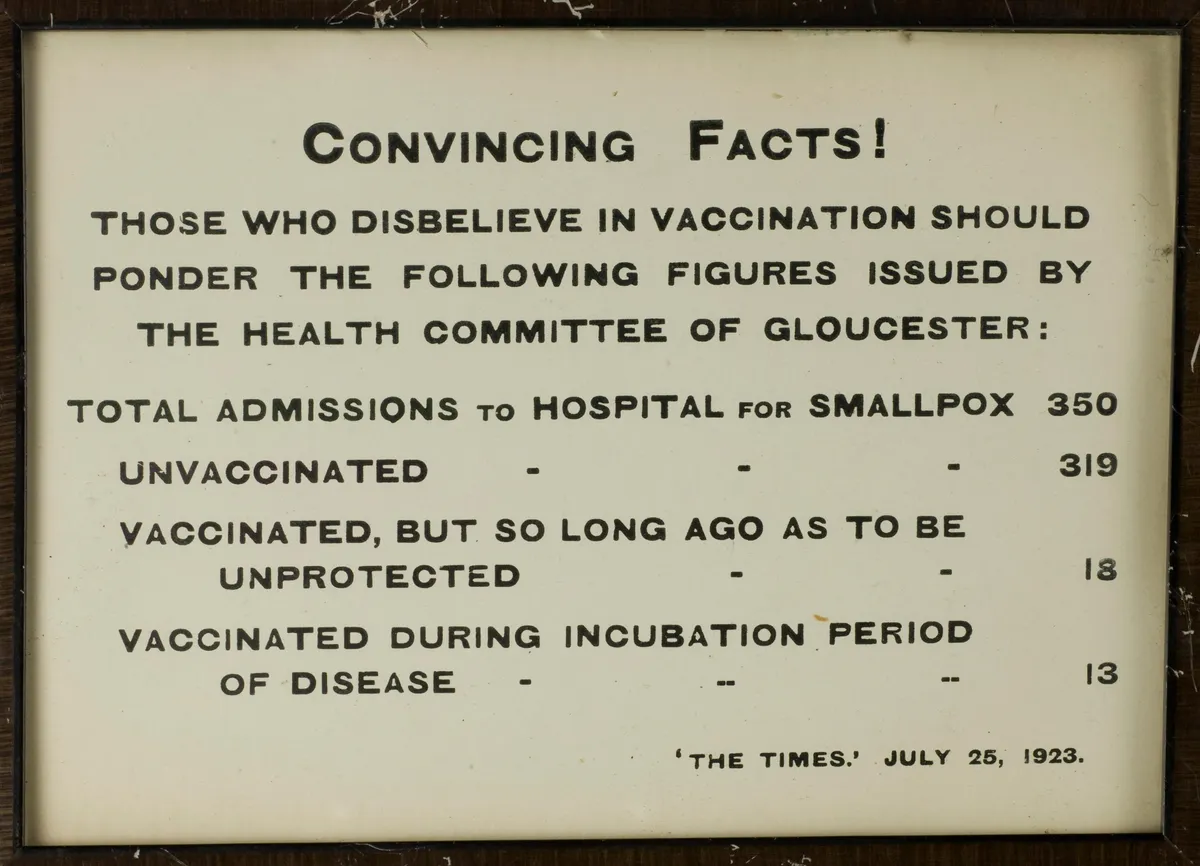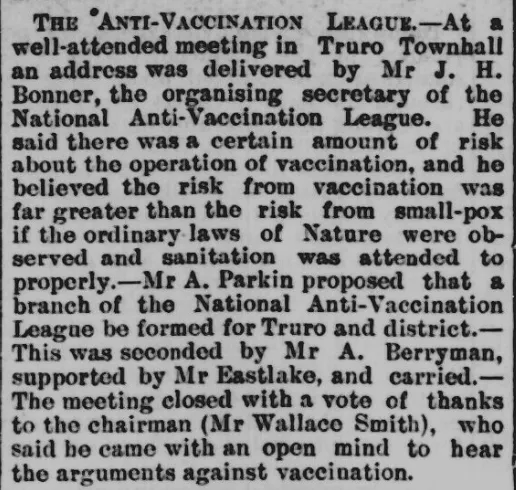The vociferous debate about the pros and cons of vaccination that rages today on social media is by no means new. For our Victorian and early 20th-century families, being vaccinated meant potential protection against smallpox – the greatest killer disease of them all. Many embraced the opportunity; others were much less compliant about doing their civic duty. Compulsory vaccination for smallpox was first made law in 1853. So, were your own ancestors willing to get their shots and, if not, why not? And how can you find out?
You may also like:
- How to start a family tree
- The bustling street markets where the working class could buy anything in Victorian London
- When is Extra Life: A Short History of Living Longer on TV?
As now, anti-vaccination sentiment occasionally spilled onto the streets. On 23 March 1885, a large demonstration erupted in Leicester. An estimated 40,000–200,000 people marched from the city’s Temperance Hall carrying flags and banners emblazoned with anti-vaccination slogans. Led by the Leicester Anti-Vaccination League, the rally was fronted by a large contingent of men who had recently been imprisoned for not allowing their children to be vaccinated. Behind them came a still larger number whose goods had been seized and sold by public auction after they had failed to pay fines for not complying with laws that made vaccination compulsory.
Hordes of unvaccinated children riding ponies plus carts boasting all manner of effigies representing the evils of vaccination brought up the rear. A dummy of vaccination pioneer Dr Edward Jenner with his head on the guillotine took pride of place. Campaigners read out letters of support from as far afield as Belgium and the USA, and copies of the Vaccination Acts were burned.
The situation in Leicester was a complicated one. An exponential rise in the population in the early part of the 19th century had brought about the chronically crowded and unsanitary living conditions that allowed smallpox to thrive. Sadly, rates of infection had continued to be high in the city, even after the introduction of compulsory vaccination in 1853. It came to be a popular belief locally that the jab made no difference to the number of cases or their severity.
Additionally, by 1885 Leicester was widely perceived to have had great success in tackling smallpox by other, more visible means. Radical reformers had long petitioned the council for improvements in sanitation. By 1880, significant improvements in water supply and drainage systems, together with the development of antiseptics, the practice of limewashing and the use of local bylaws to insist upon isolation where outbreaks of infectious diseases occurred, had all combined to decrease cases dramatically.
By 1885, a widely reported “almost entire immunity from smallpox” in Leicester nurtured the idea that vaccination was a costly waste of time and effort as well as an affront to social liberty. A handful of deaths had also led some to believe that inoculation could even endanger life. The national newspapers reported on the thousands of Leicester citizens who were summoned to court in the first three months of the year for failing to pay fines levied for their refusal to be vaccinated.
And Leicester was not alone in its petulance against the Government’s efforts to make vaccination compulsory. Over the next few years, newspapers all across the country continued to report with sympathy the prosecution of otherwise law-abiding citizens.
For example, in 1890 William Cheney of Rushdon, Northamptonshire, was sentenced to seven days’ hard labour at Northampton Gaol for “refusing to have his child vaccinated”. Although Cheney had a weak leg from bouts of rheumatic fever, he was forced to work three hours on a treadmill and to pick 2lb of oakum a day. According to the Northampton Chronicle and Echo, his punishment caused him to collapse in the prison yard and blood to run out of his “fingers’ ends”. The injustice of having to “herd with common criminals” and sleep on a plank bed, merely for daring “to show he [had] a conscience”, was not lost on the indignant journalist.
By the last decade of the 19th century, with the potential for social unrest still high over this issue, it was evidently time for the Government to adopt a new approach that would allow for some freedom of conscience.

Although vaccination had been practised by doctors from the late 18th century, having a jab against an infectious disease only became a familiar idea to our ancestors in the 1830s. The first Vaccination Act of 1840 offered vaccination against smallpox to everybody, but did not make it compulsory.
In 1853, however, a second Vaccination Act took a much more robust approach; this time, inoculation for all infants against smallpox was made compulsory. While vaccination policy would continue to be decided by central government, funds, vaccinators and publicity were organised locally. Now when registrars registered a birth, they had to give notice to parents or guardians to vaccinate their infants, and doctors had to send a certificate to the local registrar every time they vaccinated a child.
Those who refused to allow their children to be vaccinated now faced heavy fines. When these were not paid, local authorities had the authority to seize goods and auction them off in order to raise the money; some people were even imprisoned for continual refusal to comply. Further Vaccination Acts in 1867, 1871 and 1874 tightened the laws, increased the penalties, and went on to make Poor Law guardians (and later vaccination officers) rather than registrars responsible for keeping vaccination records within their parishes. Vaccines reached prisoners, vagrants, those in orphanages and workhouses, and even the far-flung populations of the British colonies. Paperwork about vaccination now abounded, and some of this is available today in county record offices.
The second half of the 19th century saw detractors argue against vaccination on the grounds of religion, science and social liberty. Up and down the country, people on both sides attended meetings and spoke up about their views. Wealthy anti-vaxxers simply kept on paying the fines and avoiding vaccination, but during the late 1800s the voices of members of the working and middle classes who were equally opposed to vaccination but less able to fend it off with a fine clamoured more loudly.

Such was the noise from the decriers that the Government felt compelled to insert a clause into the 1898 Vaccination Act covering conscientious objectors. This allowed our ancestors to legally avoid vaccination by applying to a magistrate for an exemption and obtaining a certificate of conscientious objection. However, the onus was on our forebears to convince the magistrate that their objections to the vaccination were reasonable, and the numbers of exemptions that were granted in the first years of the 20th century remained low.
Pressure on the Government to make non-compliance easier continued. The 1907 Vaccination Act required only that parents make a statutory declaration (to a magistrate, solicitor or other official) that they confidently believed that vaccination would be prejudicial to their child’s health. This change resulted in exemptions growing to 25 per cent of all births in the country during this period.
Where to find smallpox vaccination records
Records relating to smallpox vaccination increased in number and detail as the 19th century moved on. In Essex Record Office, there are records from the 1840s – before vaccination became compulsory – for “the vaccination of all willing prisoners in Springfield Gaol”, for example, but the majority of records held in county record offices are from post-1853 when smallpox vaccination became compulsory. Look out for your forbears’ names in local registers of vaccination produced by registrars, guardians of Poor Law unions, and vaccination officers. If your relations were refusers, you might find their names on ‘Orders to Vaccinate a Child’.
Some historic vaccination registers are starting to come online. On Ancestry there is a vaccination register for Newport Pagnell, 1909-1927 and Findmypast has vaccination registers for Glasgow, 1801-1854.

Some records found in county record offices are independent initiatives on the part of local officials. In Gloucester Record Office, for example, a document entitled ‘Relieving Officer’s Register’ is described as “a rough register recording visits to households asking whether the head of the house would allow his/her children to be vaccinated”. Record offices also house ‘Applications for Certificates of Conscientious Objection to Vaccination under the Vaccination Act of 1898’, which give the names of individuals who had applied for exemption.
In addition to these fairly common sources, references to our ancestors’ vaccination history can appear in surprising places. Convict Thomas Keane, aged 21, for example, was “unsuccessfully” vaccinated on the Navarino on 1 October 1842 according to a Royal Navy medical journal held at The National Archives in Kew (ADM101/56/3/1) and on Ancestry in the collection ‘UK, Royal Navy Medical Journals, 1817–1856’.
To imagine how your forbear might have been thinking about vaccination, take a look at the national and local newspapers in the British Newspaper Archive (also available on Findmypast with a Pro subscription). Here you may read about pro- and anti-vaccination meetings and demonstrations in workplaces, meeting halls and outdoors. Often speakers and delegates are named.
After 1898, local newspapers also sometimes published the local vaccination returns detailing statistics (although not individual names) for the area including the number of births; the number of those defaulting on vaccination; the number of those who had died without being vaccinated; the number of those applying for the status of conscientious objector; and the number of those who had moved out of the area.
There are also some references to vaccination in registers of school attendance; see for example the collection ‘National School Admission Registers & Log-Books 1870–1914’ on Findmypast. In some cases, vaccination is mentioned in the notes as a reason for staff absence. As a result we know that teacher Leonard Haley was absent from West Vale Board School, Elland, in the West Riding of Yorkshire, on 7 December 1905 because he was “suffering from the effects of vaccination”.
There are also details of smallpox outbreaks and vaccination programmes within the reports of local Medical Officers of Health. London records are available online for free from the Wellcome Library's London's Pulse website and there are reports from other areas via the Wellcome Library and the Internet Archive.
And if you are really lucky, you may uncover vaccination certificates amongst family papers.
Although you may never find out what your ancestors thought about vaccination, nobody can deny that the smallpox vaccine transformed the health of the world. In 1980 the World Health Organisation declared the world free of smallpox. A victory for the vaccinators.